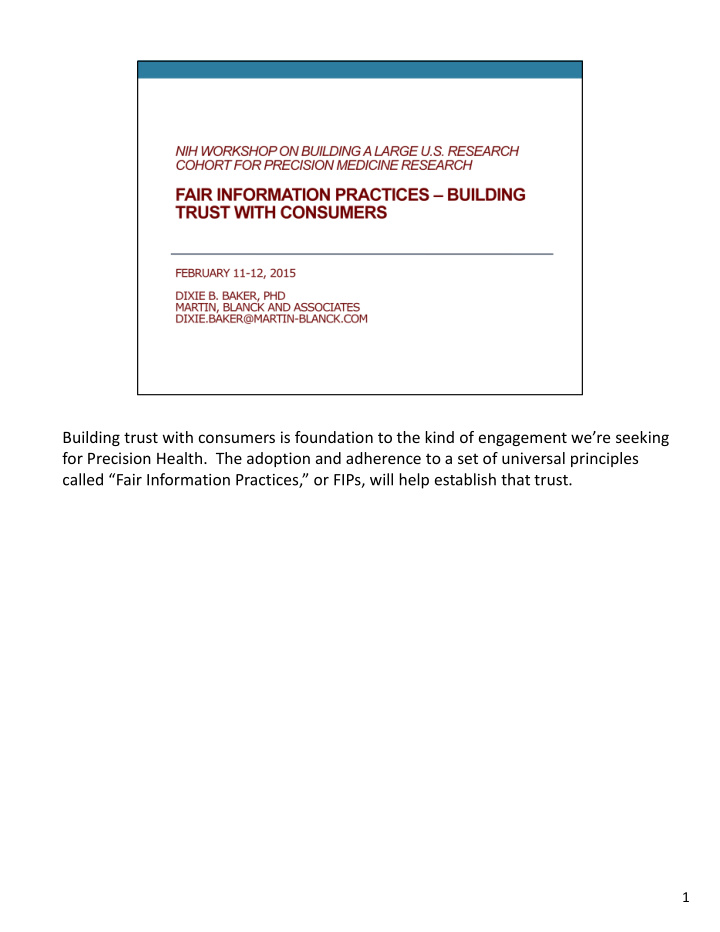



Building trust with consumers is foundation to the kind of engagement we’re seeking for Precision Health. The adoption and adherence to a set of universal principles called “Fair Information Practices,” or FIPs, will help establish that trust. 1
We see evidence of the changing role and perspective of the consumer both in the products and services consumers buy, and in their expectations regarding their own health information. For example, a high percentage of ... Smartphone apps and personal sensors are helping consumers take control of their own health. In January of this year, ... Consumers are purchasing DNA testing services from outside the traditional healthcare system, such as services from 23andMe and Ancestry.com. As consumers realize that more of their health information is being digitized, the concern over personal privacy is also increasing. Prospective participants of scientific studies have ranked privacy of sensitive information as one of their top concerns and a major determinant of participation in a study But a number of studies have shown that consumers will willingly contribute their data and biological samples to medial research – when their permission is sought. As the UK’s National Health Systemdiscovred earlier this year, recently transparency, control, and “no surprises” are key to obtaining consumers’ buy ‐ in for use of their health information in biomedical research. 2
This notional diagram depicts the challenge we face as we capitalize on the availability of massive amounts of computable health data, and our increasing capacity to analyze those data. On the x ‐ axis, we have the availability of computable clinical and genomic data, and on the y ‐ axis, we have computational power. As more electronic clinical and genomic data about individuals become widely available, and as our computational power continues to explode, we see a real promise of dramatic increases in our medical knowledge and in the quality of healthcare services. At the same time, we see a concomitant increase in risk to personal privacy. What tends to happen when consumers realize a risk to their privacy is that they will exert control by limiting the amount and quality of data they make available to healthcare providers and researchers. 3
The best way to make consumers feel comfortable making their health information available is through adherence to fair information practices, which help engender trust and engagement, enabling new knowledge and precision medicine to emerge! 4
In particular, the challenges posed by the availability of genomic data and “big data” analytics present new risks to personal privacy. An individual’s DNA is unique to that individual, making it an ideal “biometric identifier” – which is one of the 18 identifiers enumerated in the HIPAA Privacy Rule. While separating DNA data from identity and phenotype does make it more challenging to associate it with the individual it represents, a genome sequence includes many clues to help narrow down the identity possibilities – for example, the presence or absence of a Y chromosome can reduce the possibilities by about 50%, and coding of visible genetic characteristics and sets of genes commonly associated with heritage can further reduce the possibilities. Demographic metadata associated with genomic data also is reveling – it’s been estimated that the combination of birthdate, sex, and 5 ‐ digit zip code can identify ~60% of individuals in the US. (I’m sure that applies to my case.) Adding to this privacy risk is the fact that DNA is everywhere! Genomic data can be obtained from things as ubiquitous as Starbuck’s coffee cups. And the risk is not only to the individual, but also to the individual’s parents, siblings, and children. Today’s “big data” analytic technologies are becoming increasingly expert at mining information from very large volumes of data – leading one to question the Privacy Rule’s presumption that any data can be de ‐ identified. 5
The Fair Information Practices (FIPs) principles have been around for over four decades – and used throughout the world to guide regulatory processes for protecting personal privacy. 6
In 2012, Graham Greenleaf studied the many instantiations of the FIPs and concluded that these 10 principles are consistent throughout all of them. 7
8
9
10
11
12
13
14
Recommend
More recommend